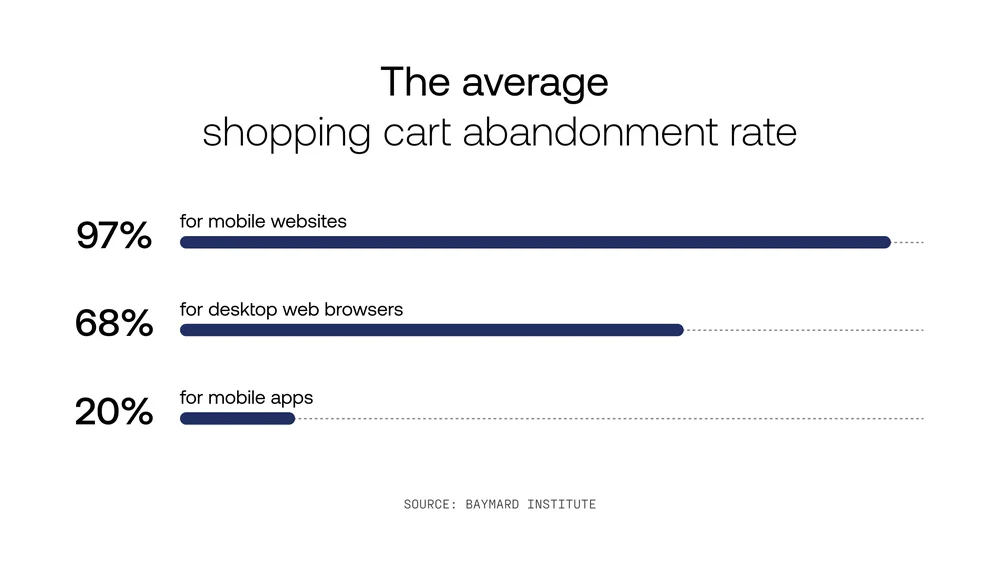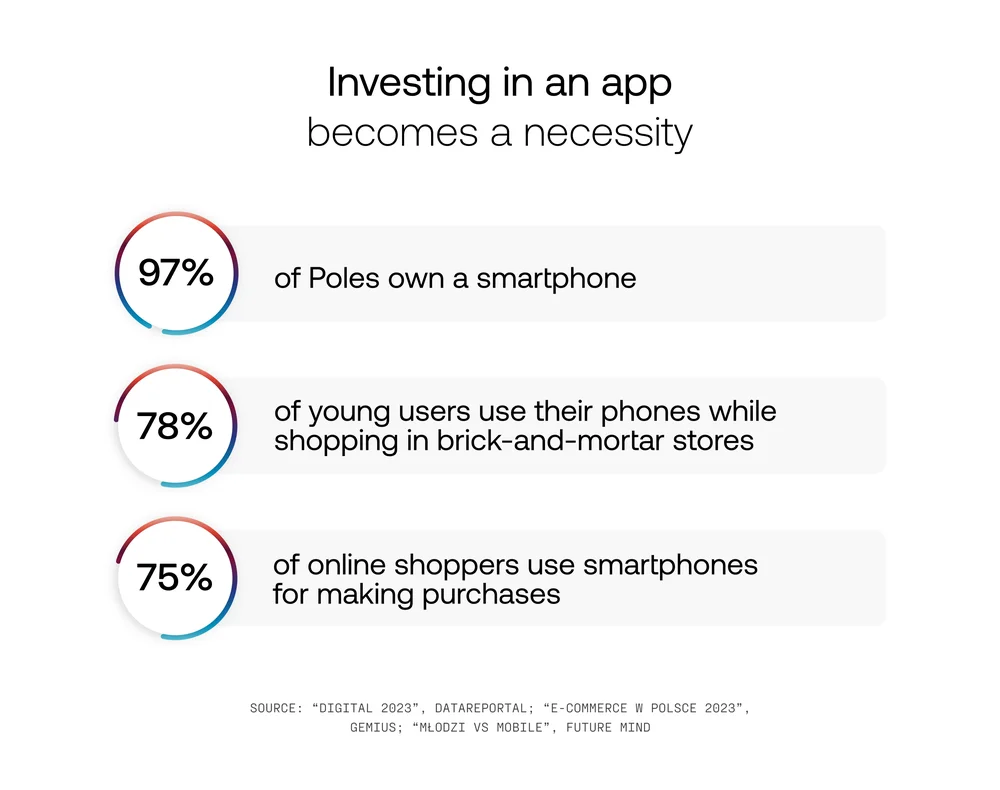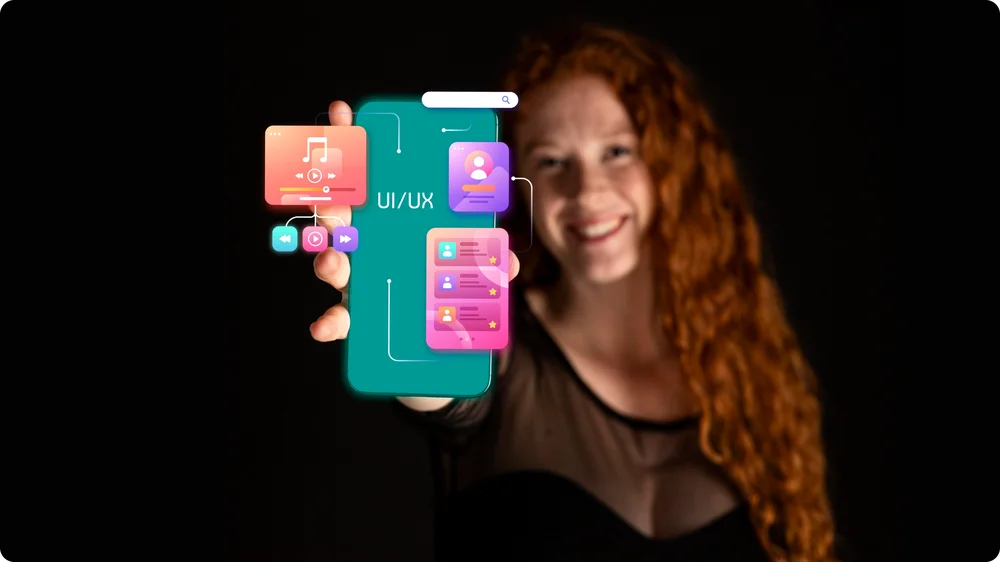
As the mobile landscape becomes more competitive, the quest for users' precious time and attention intensifies. This means single-function apps aren’t enough to effectively build customer engagement and loyalty anymore. On the threshold of 2024, brands that want to secure a top spot in the market require digital products that don't just fulfill a specific need but also resonate with users on a deeper level, fostering a long-term relationship and commitment.
Smartphones have become ubiquitous, with 97% of Poles owning one. They are the primary choice for 49% of online activities among Internet users (DataReportal, Digital 2023).
According to the recent Gemius report on e-commerce in Poland, there's been a notable shift, with smartphones emerging as the top choice for online shopping in 2022. A remarkable 75% of Poles opt for this device, and the percentage rises to 92% among the youngest age group.
What’s more, a cross-sectional analysis conducted by the Baymard Institute unveils interesting insights into online shopping behavior. The overall shopping cart abandonment rate in online stores stands at 70% on average. Importantly, these rates fluctuate depending on the device used – for mobile websites, it's a whopping 97%, for desktop web browsers – 68%, whereas for mobile apps it’s only 20%.

This data shows that investing in a mobile application can pay off, but it's essential to keep in mind that 49% of apps are uninstalled within a month of download. A key argument from users is that they “don't use the downloaded apps” (AppsFlyer, App uninstall report 2023). Our Młodzi vs Mobile report also confirms that over half of Poles aged 15-35 use apps only once or twice before finding them useless.
The conclusion? Brands building mobile apps encounter significant challenges in providing users with real value and creating engaging experiences.

Loyalty programs are stepping up as a vital player in today's marketing game. We're increasingly hearing about the cookieless world, walled garden data (closed data systems for the use of which you have to pay, but you don't actually gain access to them), and the introduction of subsequent privacy regulations. In this landscape, it's evident that success isn’t solely about acquiring customers. It’s about retaining them for establishing a sustained competitive advantage.
The era of loyalty programs centered on collecting points and exchanging them for rewards is behind us. They have evolved into solutions that genuinely engage and activate customers, thus seamlessly integrating into business models.
But at the end of the day, the fundamental objective of a loyalty program remains the same – to express appreciation and reward users. Customers expect these rewards to be immediate, surprising, enjoyable, and not overly effort-consuming.
Looking at loyalty programs from this new perspective, today’s mobile apps are designed to retain customers, ensure their continued engagement, and, as a result, generate more revenue. Apps utilize data to enrich user experiences and can provide rewards, not necessarily in the form of points or tangible items, but valuable incentives that encourage specific behaviors.
Active users serve as a metric indicating the number of unique individuals interacting with the app within a specific timeframe. It allows tracking growth, churn, and app stickiness.
Of course, depending on the industry or business goals, these interactions can be defined in the way that best suits the situation and context. It could be launching the app, logging in, or performing a specific action.
The frequency of user interactions with a digital product is also analyzed based on the nature of the business. For apps that expect frequent interactions, such as language learning apps, measuring this metric on a daily basis (DAU, Daily Active Users) proves the most valuable. On the other hand, for digital products such as airline apps, where interactions may not occur as regularly, tracking user activity on a monthly basis (MAU, Monthly Active Users) provides a more relevant perspective.

Jeffrey Gitomer, the American sales and loyalty expert, teaches us a valuable lesson: “You don't earn loyalty in a day. You earn loyalty day-by-day.” Hence, the DAU/MAU metric becomes particularly intriguing. It allows measuring the number of active users engaging with the app within 24 hours over the course of a month. It determines app stickiness and indicates its value and appeal to users. A result around 20% is considered good, above 25% – excellent.
The process of building user and customer engagement unfolds across three levels. The initial tier involves communication, specifically aligning communication strategies with technological capabilities such as personalization, recommendations, and the use of push notifications. These are everyday operational activities that can be continuously optimized in a straightforward and fast manner.
User experience is one level down. This entails ensuring that user interactions with the app are not only easy but also enjoyable – encompassing elements like seamless sign-ups, well-configured search functions, high-quality images, the availability of interactive elements… The list goes on. Although delivering excellent experiences may not be a walk in the park, industry standards have been established and are widely recognized. While optimizing implemented solutions may not be as straightforward as in the case of the communication level described above, it’s still relatively easy to do.
However, at the heart of an engaging app lies the layer of value delivered to users, as well as the reasons that drive them to use it regularly. We're seeing a clear trend in the market – brands are shifting away from single-function apps.
Shopping apps, for instance, are no longer just for making purchases. Brands are increasingly integrating additional functionalities that offer value to customers while aligning with the brand's values and vision. For example, apps of companies selling sportswear (low interaction level) offer engaging workout plans in video format (high interaction frequency).
Developing an engagement strategy for a new or existing app requires establishing clear business goals and specific success metrics. This process involves gaining a profound understanding of user behaviors, identifying their needs, staying informed about trends impacting the specific business and target audience. Additionally, it requires thorough knowledge of both direct and indirect competitors. Only such a comprehensive approach, supported by research, can answer the key question – how to meet customer needs at every stage of their journey and help them fulfill specific “missions” in their lives.
It's important to remember that your brand, product, or service is often just a brief stop in this journey. The key to success is the ability to find additional features that naturally add value to this stop, introduce elements “before” or “after”, and make it possible to build deeper, emotional relationships with customers. This always translates into higher retention, increased purchase frequency, higher basket value, reduced price sensitivity, and a greater likelihood of customers recommending your brand to others.

When seeking ways to create an engaging app, it's also worth considering how to step into the phygital world – it’s about blending physical and digital experiences. Phygital involves crafting immersive experiences in the natural environment of consumers. Just think of scanning barcodes in a physical store to access additional product information, using augmented reality technology, integrating user behavior data from native system apps… These are just a few examples. As much as 78% of young people aged 15-20 use their phones while shopping in brick-and-mortar stores, so the attempts to leverage the phygital trend seems to be a natural direction.
Another crucial aspect of creating engaging experiences involves harnessing behavioral economics to create a user-friendly behavior architecture. Employing heuristics like the IKEA effect (we favor things we've contributed to creating), the illusion of progress (starting something increases the likelihood that we’ll want to finish it), or social proof (we tend to mimic the behavior of others) are just a few strategies that can boost app stickiness.
Every app has the potential to evolve into a “love app” and contribute to achieving business goals. This is especially true if it's built by a brand that can establish a strong emotional connection with customers and is willing to continuously increase stickiness and usability of the digital product.
To effectively compete for users’ time and attention in 2024, it’s crucial to develop a carefully planned in-app engagement strategy that genuinely adds value to customers’ lives and broadens the range of "missions" they can accomplish within the app.
This not only boosts the frequency of interactions with the app but also presents an excellent chance to collect more data for refining the strategy and aligning it more closely with users’ preferences down the road.